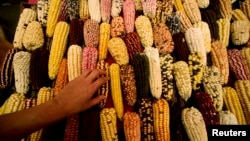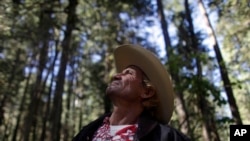Mexico's ancient civilizations cultivated crops such as maize, tomatoes and chilies for thousands of years before the Spanish conquerors arrived — and now those native plants could hold the key to sustainable food production as climate change bites, said a leading ecologist.
José Sarukhán Kermez, who helped set up Mexico's pioneering National Commission for the Knowledge and Use of Biodiversity (CONABIO), said that analyzing the genetic variability of traditional crops, and supporting the family farmers who grow most of the world's food offered an alternative to industrial agriculture.
“We don't need to manipulate hugely the genetic characteristics of these [crops] … because that biodiversity is there — you have to just select and use it with the knowledge of the people who have been doing that for thousands of years,” said Sarukhán, CONABIO's national coordinator, in a telephone interview.
The emeritus professor and former rector of the National University of Mexico (UNAM) recently won the Tyler Prize for Environmental Achievement, often referred to as a “Nobel for the Environment.”
Making use of the knowledge held by indigenous groups is “absolutely essential,” Sarukhán told the Thomson Reuters Foundation.
That requires working with a wide range of people, from local cooks to small-scale farmers, especially in states like Oaxaca and Chiapas in the south of Mexico where indigenous farmers have a strong traditional culture, he said.
“They haven't gone to university, and they don't have a degree — but they damn well know how to do these things,” he said.
For example, they discover and incorporate new knowledge as they exchange seeds with peers from different areas.
Key is funding
CONABIO is hoping to win some $5 million in funding from the Global Environment Facility for a five-year project worth more than $30 million to speed up research into indigenous crops.
The aim is to enrich the commission's vast online database of biodiversity, with a view to influencing national agricultural policy, said Sarukhán.
CONABIO's information on the genetic adaptability of native plants will enable scientists to develop new lines that can tolerate wetter or more arid conditions as the climate changes, he said.
Highlighting the potential of climate-adapted native crops, Sarukhán said around 60 types of maize are grown across Mexico, from the coast to 3,000 meters (9,843 feet) above sea-level, while only a handful of species are sold commercially.
Forest protection
With Mexico's hugely varied ecosystems and biodiversity under threat, the ecologist urged a greater focus on schemes to boost local incomes rather than giving grants to encourage people to maintain vast swaths of the country's forest.
Projects like growing organic coffee in Oaxaca's forests or ecotourism in Chiapas are helping provide communities with a decent income and an incentive to protect the environment, he said.
Rural and indigenous communities own 60 to 70 percent of all Mexico's forests and natural ecosystems, he noted.
“That is the patrimony they have — they don't have anything else to live on,” Sarukhán explained. “There are ways in which you can combine the sustainable management of the forest with more attractive incomes for the owners of the forest.”

